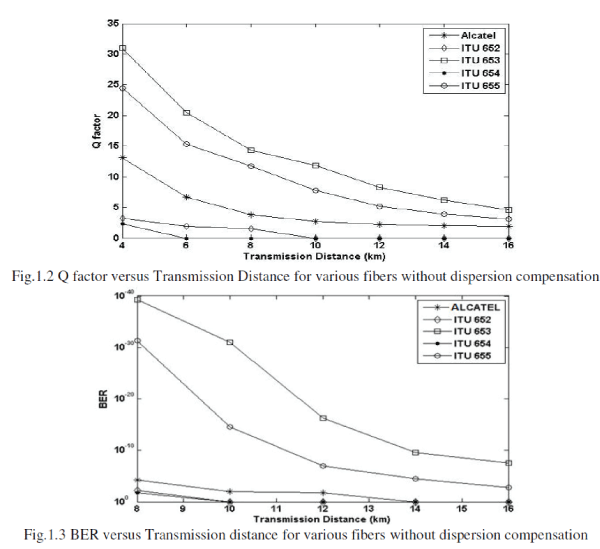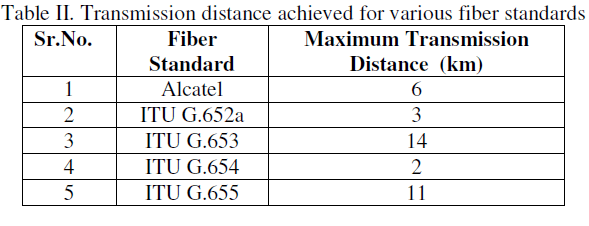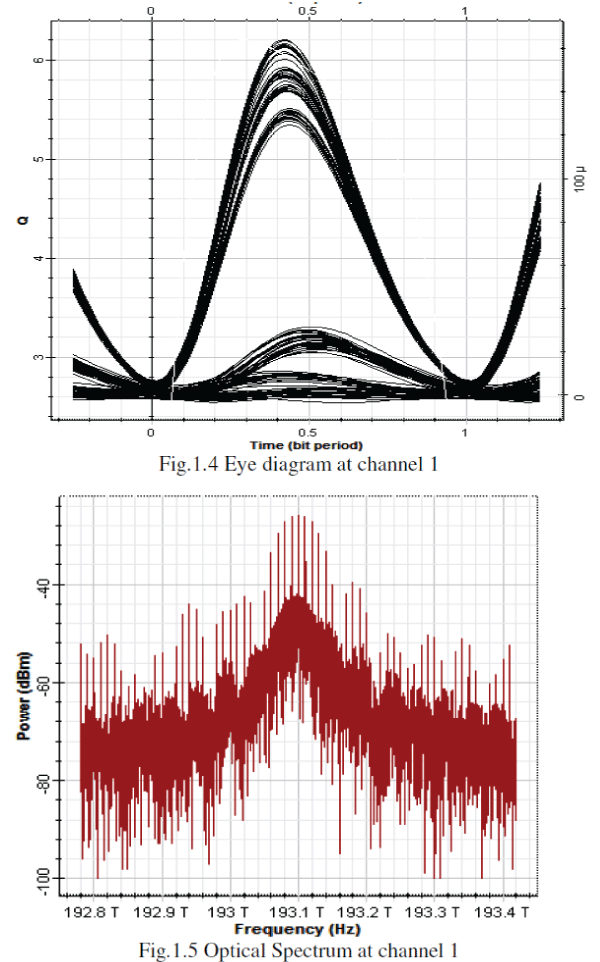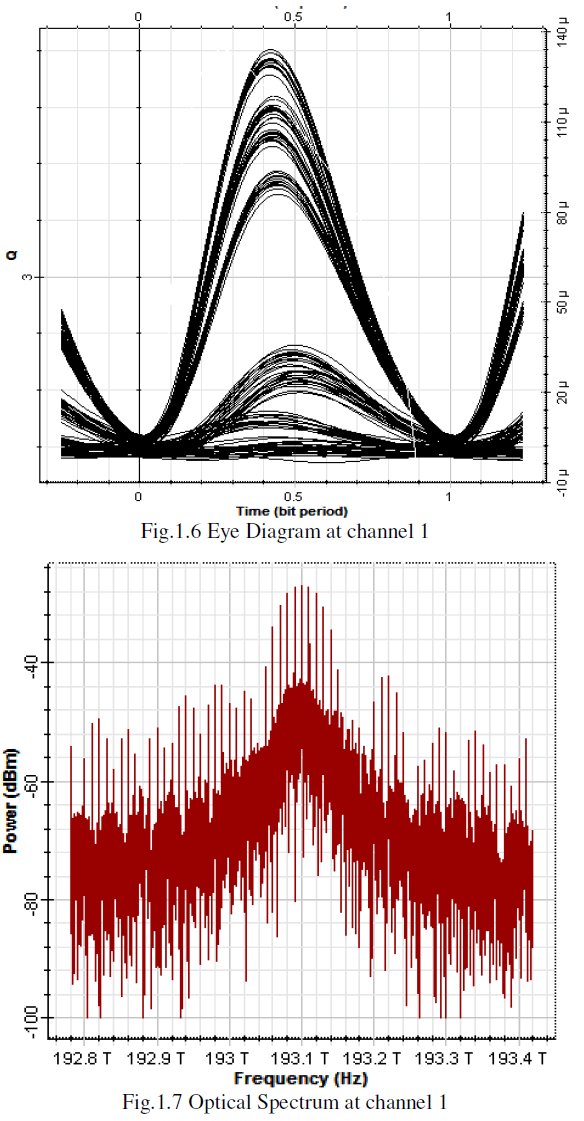ISSN ONLINE(2319-8753)PRINT(2347-6710)
ISSN ONLINE(2319-8753)PRINT(2347-6710)
Jyotsana1, Ramandeep Kaur2, Rajandeep Singh3
|
| Related article at Pubmed, Scholar Google |
Visit for more related articles at International Journal of Innovative Research in Science, Engineering and Technology
Optical Time Division Multiplexing (OTDM) is a very powerful technique that provides very high capacity of data over optical fiber. Various system impairments affect the performance of OTDM transmission. The performance of 40 Gbps OTDM system is evaluated and compared using different fiber standards (Alcatel, ITU G.652, ITU G.653, ITU G.654 and ITU G.655). ITU G.653 gives optimum performance with the reach of 14 km at Q factor of 6.20 with an acceptable bit error rate of 10-10 without compensation among all fibers.
Keywords |
| OTDM, ITU G.652, ITU G.653, Alcatel |
INTRODUCTION |
| The increasing request for broad-band communication services demands telecommunication networks offering line capacities highly exceeding those of existing facilities. Optical Time Division Multipexed (OTDM) is a useful technique to increase the transmission capacity of a given fiber link additionally to the widely used concept of wavelength-division multiplexing (WDM). Although, the commercially available electronic components are limited to about 10 Gbps data rate, still there is possibility to enhance the system data rate by deploying OTDM technique [1]. The basic principle of OTDM technique is to multiplex a number of low bit rate optical channels in time domain. As soon as transmission bit rates increase from 10 to 40 Gbps and beyond, dispersion emerges as a critical issue on all kind of fibers [2]. When installing new transmission lines, network operators have to decide which fibers will best meet future traffic requirements with acceptable performance for the large transmission distance [3]. At high bit rate transmission or above over standard fibre is an attractive way of upgrading the existing network capacity and dispersion limits the transmission distance to < 3km [4]. Hence it is of utmost requirement to investigate the several fiber standards i.e. Alcatel, ITU G.652, ITU G.653, ITU G.654 and ITU G.655 for uncompensated 40 Gbps OTDM systems. This paper is organized as follows. After introduction, Section II provides simulation setup used in the experiments. Section III describes results and discussions. Lastly, Section IV gives the conclusion. |
SIMULATION SETUP |
| The simulation setup of 40 Gbps Optical Time Division Multiplexed system is shown in Fig.3.1.The set up consists of transmitter, optical fiber and receiver. On transmitter side, laser operating at wavelength of 1552 nm with an external amplitude modulator driven by the electrical pulse generator (RZ pulse generator) with a pseudo random bit sequence (PRBS). The input power of laser is 3 dBm and linewidth is 0.1 MHz. Each signal is then followed by an optical delay of 0 ns, 0.025 ns, 0.05 ns and 0.075 ns respectively. Then multiplexer combines the four signals having data rate 10 Gbps to form a 40 Gbps signal and then launched into the optical fiber. The 40 Gbps OTDM signal travels over an optical fiber. The fibers under investigation are: Alcatel, ITU G.652a, ITU G.653, ITU G.654 and ITU G.655. |
 |
| On the receiver side, 40 Gbps optically modulated signal is split into four 10 Gbps signals and fed to the demodulator driven by an optical clock of 10 GHz and RZ pattern generator. The optical signal is then converted into electrical domain with the help of PIN photo detector and results can be seen using BER analyzer. |
RESULTS AND DISCUSSIONS |
| The effect of dispersion is analyzed over different fibers (Alcatel, ITU G.652a, ITU G.653, ITU G.654 and ITU G.655) without dispersion compensation at 40 Gbps OTDM system in terms of received Q-factor and transmission distance. The parameters used in the simulation for different fibers and DCF are shown in table I |
 |
| To analyze the system performance, the results have been taken at first channel with varied dispersion value of different fiber standards: Alcatel, ITU G.652a, ITU G.653, ITU G.654 and ITU G.655. From the results, It has been observed that except ITU G.653, all fiber standards travel very less transmission distance without dispersion compensation whereas ITU G.653 travel 14 km distance since it has least dispersion value (D=3.5ps/nm.km) as shown in Fig.1.2. Fig.1.3 shows the BER variations at channel 1 of OTDM system with length of ITU G.653. From the graph it is found that at length of 14 km, the BER obtained is 10-10. |
 |
| Table II. illustrates the performance of various fiber standards based without dispersion compensation with signal input power of 3dBm. It has been found that the best performance is shown by the ITU G.653 fiber. |
 |
| Fig.1.4 and Fig.1.5 shows the eye-diagram and optical spectrum analyzer received at Q=6.02 at distance of 14 km, showing a clean eye opening. |
 |
| Fig.1.6 and Fig.1.7 shows the eye-diagram and optical spectrum analyzer received at Q = 6.02 at distance of 18 km, showing a clean eye opening. |
 |
CONCLUSION |
| It has been concluded that bit error rate is deciding factor to select the fiber over long distances. The dispersion places l imit on the transmission distance for high data rate OTDM transmission system. Therefore fiber dispersion compensation is indispensable to achieve maximum transmission distance at 40 Gbps. From the results and discussions, it is seen that dispersion shifted fibers are anomalous and normal are performing better for long distance. It needs dispersion compensation after travelling 14 km of transmission distance. ITU G.653 exhibits maximum transmission distance of 14 km with Q factor 6.20 at acceptable bit error rate of 10-10. In case of ITU G.652a, requires dispersion compensation even after every 2 km distance. |
References |
|